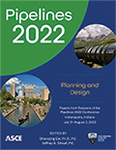Restoration Data Collection and Modeling for a Modified Cross-Section Close Fit Lining Trenchless Technology Application
Publication: Pipelines 2022
ABSTRACT
Modified cross-section trenchless lining methods include deformed and reformed, swagelining, and rolldown. A modified cross-section technology used in this study is to install a close fit HDPE lining in the existing host pipe. A flexible HDPE lining pipe material is extruded through a smaller diameter swage die to create its cross-sectional profile reduction temporarily. The deformed lining wall profile is restored after being installed in the existing host pipe. The principle of this trenchless technology was developed over 30 years ago by British Gas and United Utilities to address failing buried pipelines without excavation. This technology has been used for gas main, water main, and sewer force-main trenchless rehabilitation. The restoration rate and time are two significant performance factors to ensure constructability and quality control during the field application. However, technical information for the two factors is limited and not widely available for engineers, owners, and contractors. The focus of this paper is twofold: (1) description of a 50-m steel-framed pilot test bed for the restoration rate versus time test, and (2) verification of a hypothesis of HDPE pipe restoration by measuring cross-section profile and development of a prediction model for future field application. The project team selected 450 mm (approximately 18 in.) (DR 13.5) and 630 mm (approximately 24 in.) (DR 26) outside diameter HDPE pipes through different swage die sizes to verify the magnitude of the cross-section profile reduction between 6.7% and 17.14%. During the tests, the ambient temperature data were constantly monitored without artificial heating or steaming source to increase flexibility. A conventional static pipe bursting hydraulic rig rated 60 bars (21 metric tons) was used to pull HDPE pipe through the swage dies. This paper summarized the data collected from eight tests and a time-dependent deformation restoration prediction model. The authors anticipate that the test results and the prediction models in this paper provide a better understanding of the restoration behavior of the modified cross-section close fit trenchless rehabilitation technology to engineers, owners, and constructors.
Get full access to this article
View all available purchase options and get full access to this chapter.
REFERENCES
US EPA. (1999). Collection Systems O&M Fact Sheet – Trenchless Sewer Rehabilitation, EPA 832-F-99-032, United States Environmental Protection Agency, Office of Water, Washington DC.
Grafenauer, T. (2013). Renewing Life of Large Diameter Pressure Pipelines with HDPE through Swagelining Technology, ASCE Pipelines 2013.
Malgorzata, S., and Wobel, G. (2008). Influence of Temperature on Friction Coefficient of Low Density Polyethylene, Journal of Achievements of Materials and Manufacturing Engineering, Vol. 28, Issue 1.
ASTM F1533. (2020). Standard Specification for Deformed Polyethylene (PE) Liner, ASTM International.
Information & Authors
Information
Published In
History
Published online: Jul 28, 2022
Authors
Metrics & Citations
Metrics
Citations
Download citation
If you have the appropriate software installed, you can download article citation data to the citation manager of your choice. Simply select your manager software from the list below and click Download.
